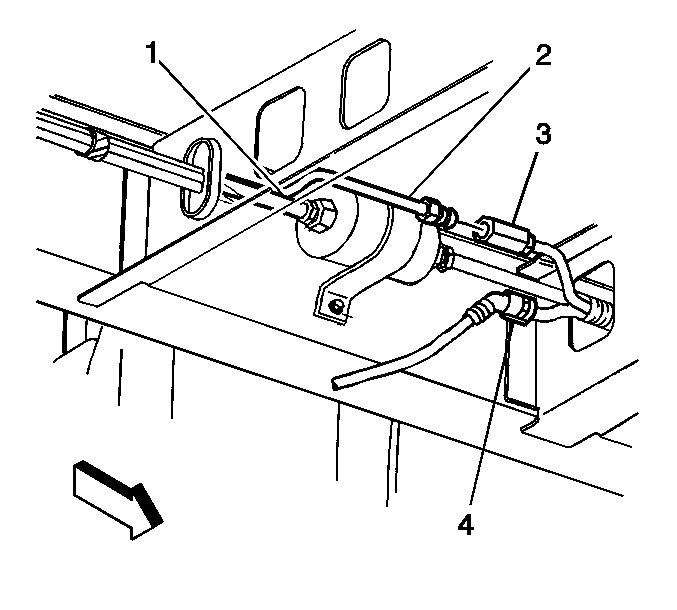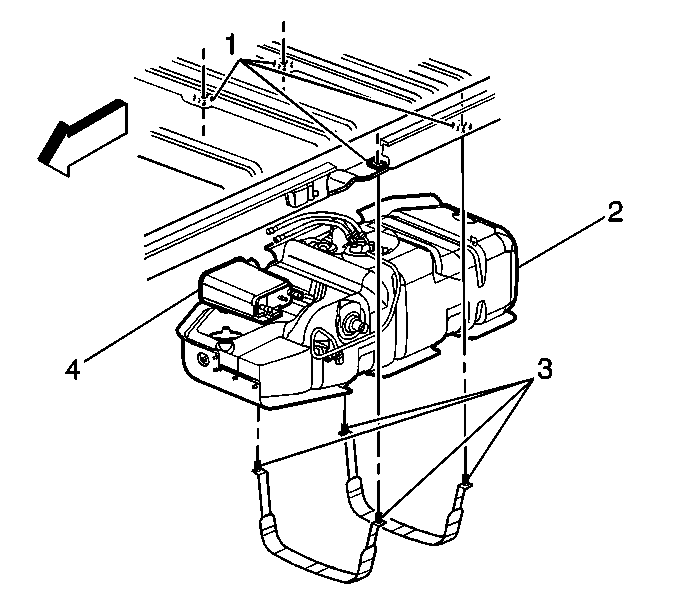Removal Procedure
- Relieve the fuel system pressure. Refer to Fuel Pressure Relief .
- Drain the fuel tank. Refer to Fuel Tank Draining .
- Raise the vehicle. Refer to Lifting and Jacking the Vehicle in General Information.
- Loosen the filler neck hose clamp at the fuel tank.
- Disconnect the fuel tank filler neck from the fuel tank. Refer to Filler Tube Replacement .
- Disconnect the fuel tank pipes (1) from the fuel feed (2) and fuel return (5) pipes.
- Disconnect the EVAP purge pipe (4).
- Disconnect the fuel sender electrical connector (2).
- Support the fuel tank.
- Remove the fuel tank strap bolts (3) and the fuel tank straps.
- Remove the fuel tank.
- Remove the fuel sender assembly (4). Refer to Fuel Sender Assembly Replacement .
- Remove the EVAP canister (1). Refer to Evaporative Emission Canister Replacement .





Installation Procedure
- Install the fuel sender assembly (4). Refer to Fuel Sender Assembly Replacement .
- Install the EVAP canister (1). Refer to Evaporative Emission Canister Replacement .
- Install the fuel tank and the fuel tank straps.
- Install the fuel tank strap bolts (3).
- Connect the fuel sender electrical connector (2).
- Connect the EVAP purge pipe (4).
- Connect the fuel tank pipes (1) to the fuel feed (2) and fuel return (5) pipes.
- Connect the fuel tank filler neck to the fuel tank. Refer to Filler Tube Replacement .
- Lower the vehicle.
- Refill the fuel tank.
- Install the fuel tank filler cap.
- Connect the negative battery cable.
- Inspect for leaks using the following procedure.
- Install the engine cover. Refer to Engine Cover Replacement in Interior Trim.


Notice: Tighten the strap fasteners by steps, alternating between the fasteners, until the specified torque is reached. A failure to tighten the strap fasteners as specified will cause the bottom of the tank to flex upward. This will result in the fuel gauge indicating that there is fuel remaining in the tank when the tank is empty.
Important: When removing or replacing the fuel tank, the fuel tank support fasteners should never be reused. Always use new fasteners when installing the fuel tank.
Notice: Use the correct fastener in the correct location. Replacement fasteners must be the correct part number for that application. Fasteners requiring replacement or fasteners requiring the use of thread locking compound or sealant are identified in the service procedure. Do not use paints, lubricants, or corrosion inhibitors on fasteners or fastener joint surfaces unless specified. These coatings affect fastener torque and joint clamping force and may damage the fastener. Use the correct tightening sequence and specifications when installing fasteners in order to avoid damage to parts and systems.
Tighten
Tighten the strap bolts to 35 N·m (26 lb ft).



If a memory retention device was not used, please reset (to the extent possible) all devices that lost their memory after the battery was disconnected.
| 13.1. | Turn ON the ignition, with the engine OFF, for 2 seconds. |
| 13.2. | Turn OFF the ignition for 10 seconds. |
| 13.3. | Turn ON the ignition, with the engine off. |
| 13.4. | Inspect for fuel leaks. |
